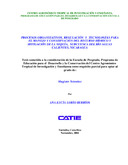| dc.contributor.author | Lorío Berríos, Ana L. | |
| dc.date.accessioned | 2014-10-20T05:24:49Z | |
| dc.date.available | 2014-10-20T05:24:49Z | |
| dc.date.issued | 2004 | es_ES |
| dc.identifier | 366616 | es_ES |
| dc.identifier.uri | https://repositorio.catie.ac.cr/handle/11554/5384 | |
| dc.identifier.uri | http://orton.catie.ac.cr/repdoc/A0283e/A0283e.pdf | es_ES |
| dc.description | Tesis (M. Sc) -- CATIE, Turrialba (Costa Rica), 2004 | es_ES |
| dc.description.abstract | La investigación se realizó en la subcuenca Aguas Calientes municipio de Somoto y San Lucas, con el objetivo de analizar los procesos organizativos y su relación con la problemática existente en cuanto a disponibilidad de agua. Se estudiaron los factores que inciden en esta problemática, tal como la ausencia y/o falta de aplicación de reglas y/o leyes que regulan el uso del recurso hídrico y las limitantes para una adecuada organización. También trata de conocer las fortalezas y capacidad de resiliencia de los diferentes grupos poblacionales para dar respuesta a la problemática del agua. El estudio contribuye a plantear estrategias, entre las que tenemos, medidas regulatorias en donde no existe regulación del agua. Las medidas que se proponen son la "tarifa hídrica" y el "canon" por consumo. También se sugiere la utilización de mecanismos de mayor engranaje entre las organizaciones de base, agencias de desarrollo y gobierno local para efectivizar la labor en la conservación y optimización del recurso hídrico, bien tan crítico y vital en la subcuenca en cuestión. This study was conducted in Somoto and San Lucas, Aguas Calientes watershed with the objective of analyzing the organizational processes and their relationship with water availability. Factors within this problem such as, the absence and/or lack of application of rules and/or laws that regulate hydric resources, and the obstacles for an adequate organization were studied. The strength and resilience capacity from the local population in order to solve the problem surrounding water issues was also analyzed. This study contributed to propose strategies for regulatory measures, for instance, hydric tariffs and the canon for consumption. In addition more adequate utilization mechanisMON are recommended among base organizations, development agencies, and local governments to improve the effectiveness of water conservation and optimization, vital elements within the sub-watershed under study. | es_ES |
| dc.language.iso | es | es_ES |
| dc.publisher | CATIE, Turrialba (Costa Rica) | es_ES |
| dc.subject | CUENCAS HIDROGRAFICAS | |
| dc.subject | RECURSOS HIDRICOS | |
| dc.subject | SEQUIA | |
| dc.subject | ORDENACION DE CUENCAS | |
| dc.subject | ORDENACION DE RECURSOS | |
| dc.subject | DISPONIBILIDAD DEL AGUA | |
| dc.subject | CONSERVACION DE SUELOS | |
| dc.subject | AGENCIAS DE DESARROLLO | |
| dc.subject | PARTICIPACION SOCIAL | |
| dc.subject | LEGISLACION | |
| dc.subject | PLANIFICACION | |
| dc.subject | NICARAGUA | |
| dc.title | Organizational processes, regulation and technologies for the conservation and management of the hydric resources and drought mitigation in Aguas Calientes Watershed, Nicaragua | es_ES |
| dc.title.alternative | Procesos organizativos, regulación y tecnologías para el manejo y conservación del recurso hídrico y mitigación de la sequía, subcuenca del río Aguas Calientes, Nicaragua | es_ES |
| dc.type | Tesis de maestría | es_ES |
| dcterms.rights | acceso abierto | es_Es |
| dc.identifier.publication | Turrialba (Costa Rica) | es_ES |


